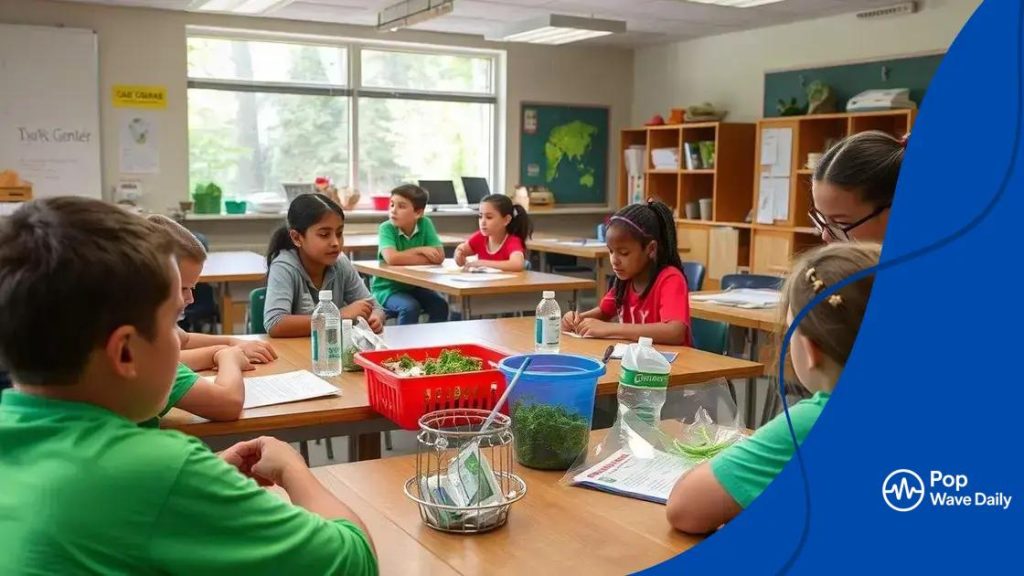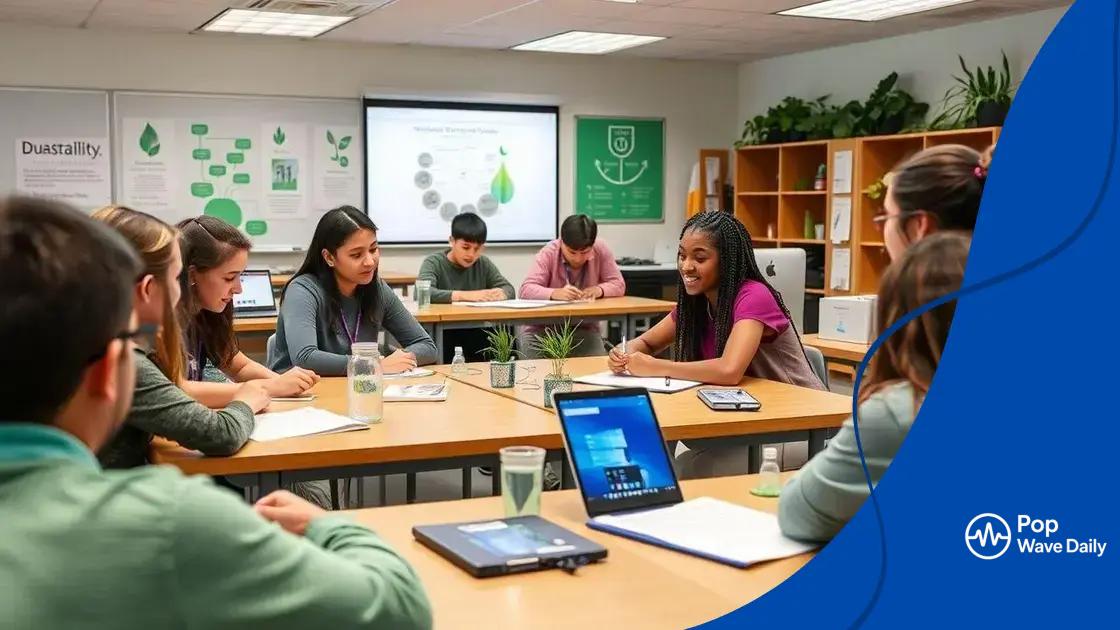Environmental education: integrating sustainability for future

Anúncios
Measuring the impact of sustainability education involves assessing student understanding, evaluating program effectiveness through various methods, and tracking behavior changes to ensure they engage with sustainable practices meaningfully.
Environmental education: integrating sustainability into curricula is more crucial than ever. But how can educators weave these principles effectively into everyday teaching? Let’s explore the exciting possibilities!
Anúncios
Understanding the principles of environmental education
Understanding environmental education is vital for fostering a sustainable future. It raises awareness about our planet and encourages people to adopt responsible behaviors. The principles of environmental education are essential tools for achieving this goal.
Key principles include:
Holistic Perspective
A holistic perspective is critical. This means viewing environmental issues as interconnected systems. For example, pollution, climate change, and biodiversity loss all affect each other. By teaching students to see these connections, we encourage them to think critically about solutions.
Anúncios
Active Learning
Active learning engages students directly. Instead of just reading texts, students participate in projects, discussions, and experiments. This hands-on approach makes learning exciting and memorable. For instance, organizing clean-up campaigns can instill a sense of responsibility and teamwork.
Critical Thinking
Fostering critical thinking is another core principle. Students should analyze and evaluate information. This skill is important in understanding the complexities of environmental issues. They can learn to question sources and figure out what is credible.
- Encourage questioning habits in the classroom.
- Use real-world scenarios for problem-solving.
- Discuss various perspectives on environmental issues.
Integrating community involvement enhances learning. By working with local organizations, students can connect theory with real-life applications. Projects can focus on local ecosystems or conservation efforts, allowing students to see their impact.
Moreover, valuing diversity in education is powerful. Incorporating different cultures and perspectives can enrich the learning experience. It helps students appreciate the various ways in which different communities interact with the environment.
Long-Term Sustainability
Finally, emphasizing long-term sustainability is crucial. Education should not only focus on immediate results but also promote practices that benefit future generations. Instilling a mentality of stewardship ensures that students become responsible caretakers of the Earth.
By understanding these principles of environmental education, educators can effectively teach students the importance of sustainability. This knowledge equips them to make informed decisions and create positive change in their communities.
Key benefits of integrating sustainability in schools
Integrating sustainability in schools offers numerous benefits for students, educators, and the community. It goes beyond traditional learning, shaping students’ minds and promoting a sense of responsibility.
Enhances Critical Thinking
One of the key benefits is that it enhances critical thinking skills. By examining real-world problems, students learn to analyze situations and develop solutions. For example, they can study local environmental issues and propose action plans. This practical approach cultivates a mindset geared toward problem-solving.
Improves Environmental Awareness
Another significant advantage is improved environmental awareness. Students gain a better understanding of how their actions affect the planet. Lessons that focus on sustainability can lead to more conscientious behaviors, such as reducing waste and conserving energy. As they become informed, students can encourage their families and communities to adopt similar practices.
- Hands-on projects encourage practical applications.
- Field trips to local conservation sites enhance learning.
- Community gardening projects can spark interest in sustainability.
Furthermore, integrating sustainability into curricula can foster collaboration among students. Group projects build teamwork skills and allow students to learn from each other. Through cooperation, they often find innovative solutions to pressing issues, empowering them to act collectively in their communities.
Encourages Lifelong Learning
Integrating sustainability also encourages lifelong learning. When students are engaged with sustainability, they develop a habit of inquiry. They become curious about the environment and seek to learn more throughout their lives. This passion for knowledge often extends beyond school, as they continue exploring these themes as adults.
Moreover, schools that prioritize sustainability create an inclusive environment. They bring together students from diverse backgrounds, enhancing discussions and perspectives on environmental issues. This diversity not only enriches the learning experience but also reinforces the idea that sustainability is a shared responsibility.
Promotes Healthy Lifestyles
Finally, sustainability education promotes healthier lifestyles. It encourages students to think about their choices, both in nutrition and environmental impact. For instance, a focus on local food sources can lead to healthier eating habits. By learning about food systems, students are more likely to appreciate fresh produce and make informed dietary choices.
Incorporating sustainability in education not only benefits students but also prepares them to be responsible citizens. The integration of these principles fosters a proactive attitude toward environmental stewardship, paving the way for a healthier future for all.
Innovative teaching methods for sustainability

Innovative teaching methods for sustainability can transform how students engage with environmental issues. These approaches make learning interactive and relevant, allowing students to connect theory with practice. Education becomes a driving force for change when these methods are utilized effectively.
Project-Based Learning
One effective method is project-based learning. This approach allows students to take on real-world challenges. For instance, they might develop a recycling program for their school. Working in teams, they research best practices, create materials, and implement their ideas. Such hands-on projects make the learning experience more impactful.
Experiential Learning
Another innovative approach is experiential learning. This method encourages students to learn through direct experience. By participating in field trips to local conservation areas, they gain firsthand knowledge of ecosystems. Activities like planting trees or maintaining community gardens teach valuable lessons about care for the environment.
- Field trips to nature reserves enhance understanding of biodiversity.
- Workshops with environmental professionals provide insights into sustainability careers.
- Service-learning projects create connections with local organizations.
Integrating technology can also enhance teaching methods. For example, using virtual reality can immerse students in different ecosystems. They can explore coral reefs or forests without leaving the classroom. This technology brings lessons to life and adds an exciting twist to learning about nature.
Interdisciplinary Approaches
Employing interdisciplinary approaches can make sustainability education even more engaging. By combining science with art, students can express environmental themes creatively. They might create art installations from recycled materials, blending artistic expression with ecological messages. This approach fosters collaboration and critical thinking while making learning enjoyable.
Peer teaching is yet another innovative method. Older students can mentor younger ones, sharing their knowledge of sustainability. This not only reinforces the material but also builds confidence in the student teachers. It creates a sense of community in the classroom, where everyone contributes to each other’s learning.
Gamification
Additionally, gamification is a powerful tool for innovative teaching. By turning lessons into games, educators can motivate students to engage more deeply. For example, sustainability challenges can promote friendly competition while encouraging cooperation. Students can earn points for recycling or tracking their energy use, making learning fun.
By implementing these innovative teaching methods for sustainability, educators can inspire the next generation to care for the environment. These strategies create dynamic learning experiences that equip students with the knowledge and skills necessary to lead sustainable lives.
Engaging students through hands-on experiences
Engaging students through hands-on experiences is an effective way to teach sustainability. These experiences allow students to learn actively and connect personally with their environment. When they participate in practical activities, they develop a deeper appreciation for nature and sustainability.
Importance of Hands-On Learning
Hands-on learning promotes retention of knowledge. When students physically participate in activities, they are more likely to remember the lessons. For example, planting trees or creating a garden allows them to witness the growth of their efforts. This tangible connection makes concepts of sustainability come alive.
Types of Hands-On Activities
Various types of hands-on activities can be included in sustainability education. Field trips to local eco-parks teach students about native species and ecosystems. In classrooms, they can engage in projects like building birdhouses, which support local wildlife. These activities encourage critical thinking and collaboration.
- Participating in community clean-up events fosters teamwork.
- Conducting experiments with recycling materials promotes creativity.
- Building compost bins teaches about waste management.
Moreover, such experiences build a sense of responsibility. When students take part in caring for their local environment, they learn about the impact of their actions. This fosters a sense of pride and ownership over their contributions.
Working with Community Partners
Collaborating with local organizations can enhance hands-on learning. Schools can partner with environmental groups to offer workshops or events. For instance, students can learn about aquatic ecosystems by participating in river clean-ups organized by local conservation groups. This community involvement connects classroom learning to real-world applications.
Furthermore, using technology can enhance hands-on experiences. Virtual reality can simulate various ecosystems, providing students opportunities to explore environments they may not visit in person. This approach creates an interactive learning experience that captivates students’ attention.
Engaging students through hands-on experiences enables them to see the relevance of sustainability in everyday life. It cultivates a generation of environmentally conscious individuals committed to making a difference.
Measuring the impact of sustainability education
Measuring the impact of sustainability education is essential for understanding its effectiveness. By evaluating how well students grasp sustainable practices, educators can improve their teaching methods. This process helps ensure that students not only learn but also apply what they have learned.
Importance of Assessment
Assessment is crucial in gauging the success of sustainability programs. Through various evaluation methods, teachers can gain insights into student engagement and knowledge retention. For example, standardized tests or quizzes can measure students’ understanding of environmental concepts. However, assessments should go beyond traditional methods.
Qualitative and Quantitative Methods
Both qualitative and quantitative methods are valuable in measuring impact. Surveys and interviews offer qualitative data, providing context to student experiences. This approach allows for understanding students’ attitudes toward sustainability. On the other hand, quantitative data can be obtained through projects or activities assessment, such as tracking how many students participate in recycling programs.
- Conduct surveys to gather feedback on sustainability projects.
- Track changes in energy consumption in schools.
- Evaluate participation in local sustainability events.
Additionally, analyzing behavior changes over time is another effective way to measure impact. For instance, observing if students engage in environmentally friendly practices after participating in sustainability education helps gauge the long-term effects of such programs. This kind of observation can be done through classroom actions or community participation.
Success Stories and Real-World Applications
Highlighting success stories can also serve as a metric. By showcasing projects where students successfully made a difference, schools can illustrate the impact of their sustainability education. This can include initiatives that resulted in reduced waste or improved biodiversity in local areas.
Furthermore, real-world applications of learned concepts are vital. Students who, for example, lead a community garden project demonstrate their understanding of sustainability principles. Such initiatives not only reinforce what they learn but also allow them to contribute positively to their communities.
Lastly, ongoing evaluation is necessary. Regularly assessing sustainability education initiatives allows educators to adapt their approaches. This ensures that programs remain relevant and effective in teaching important skills that promote environmental stewardship.
FAQ – Frequently Asked Questions about Sustainability Education
Why is measuring the impact of sustainability education important?
Measuring the impact helps educators refine teaching methods and ensures students understand sustainable practices effectively.
What methods can be used to assess sustainability education programs?
Assessment methods include surveys, real-world projects, and tracking student behavior changes regarding the environment.
How can success stories help improve sustainability education?
Success stories showcase effective projects that highlight the positive impact students can have on their communities, inspiring others.
What role does ongoing evaluation play in sustainability education?
Ongoing evaluation helps schools adapt their programs to remain relevant and effective in teaching sustainability principles.